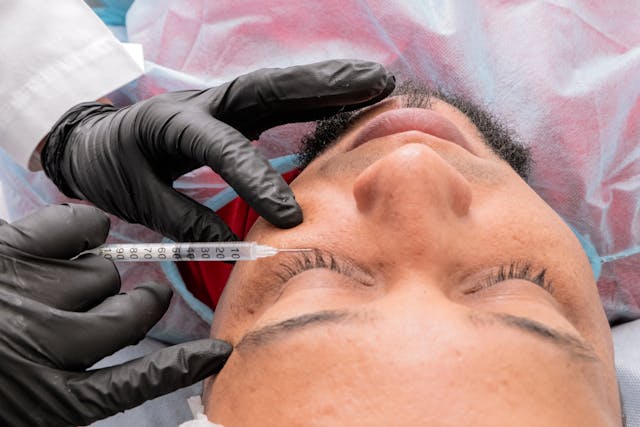The Impact of Botox Injections on Your Facial Expression and Movement
Botox, a brand name for botulinum toxin, is commonly known for its cosmetic applications, particularly in reducing the appearance of wrinkles. Over the past few decades, Botox injections have gained significant popularity for both aesthetic and medical purposes. While its primary function in cosmetic settings temporarily paralyzes muscles, the effects on facial expression and movement are noteworthy. We will explore how the lowest price botox in Bristol influences the muscles responsible for facial expressions, the emotional responses associated with these expressions, and the broader impact on movement patterns. Understanding these effects can offer insights into both the benefits and limitations of Botox in the context of facial aesthetics and body language.
Botox's Mechanism: Temporary Paralysis and Muscle Relaxation
Botox works by blocking the transmission of nerve signals to the muscles it is injected into, causing temporary paralysis of those muscles. This paralysis restricts muscle movement, reducing the visibility of wrinkles and fine lines caused by repetitive facial expressions such as frowning or squinting. While the effects are temporary, typically lasting 3 to 6 months, Botox can profoundly impact facial expressions. When injected into areas like the forehead, crow’s feet, and frown lines, Botox softens the movement of these muscles. The result is a smoother appearance, as the muscles no longer contract the same way, effectively minimizing the creases associated with aging. However, altering these muscle movements can lead to a less expressive face overall, limiting the ability to communicate through certain facial expressions.
Facial Expression: Altering Emotional Communication
Facial expressions are essential in conveying emotions such as happiness, surprise, sadness, and anger. The movements of muscles like the corrugator (responsible for frowning) or the frontalis (involved in raising eyebrows) are crucial in non-verbal communication. Botox injections that target these muscles can significantly reduce the range and intensity of facial expressions. For instance, someone who regularly uses Botox for frown lines may find it more difficult to express frustration or concern facially, as the muscle responsible for furrowing the brow is less active. While Botox users may appreciate the youthful appearance that comes with fewer wrinkles, this reduction in expressive capability can sometimes make it harder for others to read their emotional state. This can sometimes lead to misunderstandings in social or professional interactions, where facial cues are relied upon to gauge mood or reaction.
Movement Patterns: The Subtle Changes in Facial Movement
In addition to facial expression, Botox injections can also influence the broader movement patterns of the face. The injections may lead to a noticeable shift in how the face moves, especially when making facial gestures or speaking. Botox in the forehead muscles can restrict the natural lift of the eyebrows, making expressions of surprise or curiosity less pronounced. Additionally, it can affect the ability to make subtle eye movements or even cause changes in how the face moves when speaking. For example, someone who has received Botox injections in the lower face may notice that their smile appears less dynamic or more constrained. These shifts in movement may not always be immediately noticeable to the individual, but they can subtly alter how others perceive a person's expressiveness and approachability.
Botox and Emotional Expression: The Link Between Muscle and Emotion
The relationship between facial muscle movement and emotional expression is a well-documented phenomenon. Psychological research has shown that facial expressions can influence emotional experiences, as seen in the "facial feedback hypothesis." According to this theory, forming certain facial expressions can trigger the corresponding emotional state. Botox's impact on facial muscles has raised questions about whether the injection of botulinum toxin, which limits facial movement, could influence the emotions typically associated with those movements. Some studies suggest that people who receive Botox injections may experience a slight reduction in the intensity of their emotional responses due to the limited ability to express emotions through facial muscles. For example, Botox users may feel less angry or sad because the muscles associated with these emotions are less active. While the effects on emotional experiences are not always pronounced, the connection between facial expression and emotion remains an area of ongoing research.
Social Perception: Botox's Effect on How Others See You
The impact of Botox on facial expression and movement extends beyond the individual. Botox can alter how a person is perceived in social and professional contexts. The reduced ability to convey certain emotions through facial expressions may influence how others interpret a person’s mood, intentions, or level of engagement. In some cases, Botox users may appear more neutral or distant, as the limited movement of their faces can give off the impression of being less emotionally available. On the other hand, some people may find that Botox injections lead to more positive perceptions, particularly if the cosmetic effect leads to a more youthful or refreshed appearance. The broader social implications of Botox use highlight the complex relationship between facial movement and social interactions. Understanding how Botox affects communication on a non-verbal level can help individuals navigate the potential changes in how others perceive them.
Botox injections undeniably have a transformative effect on facial expression and movement, from smoothing wrinkles to altering emotions. While many people enjoy the aesthetic benefits of Botox, it’s important to consider the potential changes in non-verbal communication and emotional expression. These changes can be positive and negative, depending on personal goals and expectations. The decision to use Botox should be made with a clear understanding of how it will impact facial muscles' appearance and functionality. Whether used for cosmetic or therapeutic purposes, Botox’s influence on facial expression and movement highlights the intricate connection between physical appearance, emotional expression, and social interaction.

